
PREV ARTICLE
NEXT ARTICLE
FULL ISSUE
PREV FULL ISSUE
SELECTED MEDALS FROM STACK'S BOWERS NOVEMBER 2016 SALEThe November 2016 Stack's Bowers sale includes a great run of medals, many of which are from the John Sallay collection. Here
are several that caught my eye when the printed catalog arrived on my desk Friday. -Editor
Lot 7: 1683 Dutch West India Company Medal 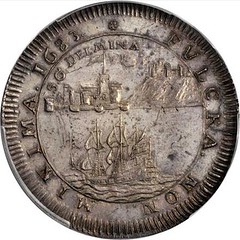 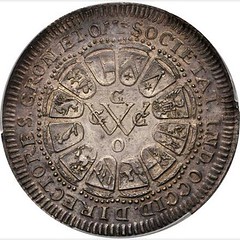 1683 Dutch West India Company. Silver. 46.0 mm. 32.6 grams. Betts-64. Plain Edge--Overstruck on a Two Ducatoon of Holland, circa 1671-1680 The Dutch West India Company (or Geoctroyeerde Westindische Compagnie) was established in 1621 by charter of the States-General of the United Netherlands. By the terms of their charter, the company was granted an official monopoly on all trade on the Atlantic including colonies in Africa, the West Indies, and North and South America. The DWC was also permitted to establish colonies in the name of the States-General, which they did with great glee and delight: Fort Oranje at Albany in 1624, Fort Nassau at Philadelphia in the same year, Fort Good Hope at Hartford in 1633, and of course Fort Amsterdam at New York City in 1626. The company attempted to populate its new colonies with assurances of wealth through the fur trade in these regions, and offered patroonships with huge tracts of land to any investor who would pay to bring 50 new colonists to the New York settlements. During the turnover of New York to the English between 1664 and 1674, the Dutch West India Company turned its attention to settlements in modern-day Guyana and Suriname as well as African possessions such as Angola and Madagascar. In 1674, the company disbanded and reformed as the Nieuwe West Indische Compagnie, whose sphere included Curacao, the aforementioned properties on the north coast of South America, and several African ports. Their trade revolved around sugar cane, coffee, chocolate, and slaves. This medal depicts and names one of the jewels of the Dutch West India Company crown during this period when the role of the company was changing from its height as a colonizing force in the 1620s and 1630s. The castle of St. George d'Elmina in Ghana was built in 1482 by the Portuguese and captured in 1637 by the Dutch West India Company, who used it as a center of trade in slaves and gold coming from the port of Elmina, which translates as "the mine" in Portuguese, to the Caribbean, Brazil and mainland North America. The castle, which still stands and is the oldest European building in Africa, is depicted with the striped flag of the Dutch West India Company flying above it and a well detailed galleon in the foreground. To read the complete lot description, see: Lot 25: Betts-382 Lord Anson Medal in Gold 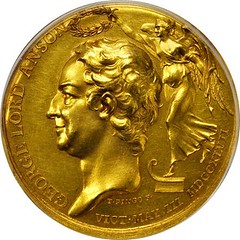 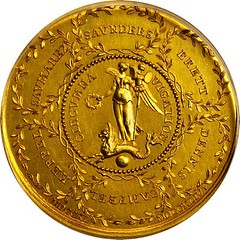 Historic Betts-382 Lord Anson Medal in Gold Thomas Pingo was perhaps the most talented of the English medalists working in the third quarter of the 18th century. He was a favorite of the London elite, a group of people who pursued numismatics, history, and art with equal vigor. Pingo's Seven Years War series for the Society for Promoting Arts and Commerce (SPAC, later known as the Royal Society of the Arts) is well known to Betts medal enthusiasts, but other works like the 1772 Botetourt for the College of William and Mary and this Anson medal are also part of the Betts corpus. Anson became a celebrated figure throughout the British Empire; Anson County, North Carolina is named for him, as is Anson, Maine. His fame was sealed by his circumnavigation, highlighted by his capture of the "Manilla Galleon," the Nuestra Senora de la Covadonga, which yielded over 1 million 8 reales in silver. To read the complete lot description, see: Lot 29: 1756 Kittanning Destroyed Medal 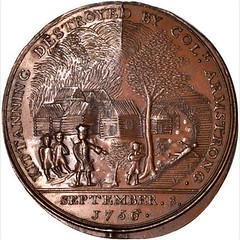 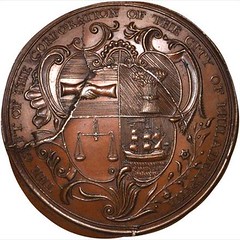 1756 Kittanning Destroyed Medal. Bronze. 44.1 mm. 47.5 grams. Betts-400, Julian MI-33. Original Dies. MS-64 BN (NGC). A later state of this famous and popular medal, nearly 7.0 mm thick at the centers to allow for detail from the badly broken and sunken dies. The surfaces are attractive light brown with just a few well hidden specks, though the bottom edge shows a square punchmark or dent at 6 o'clock, essentially invisible from either side. The obverse is boldly cracked at 6 o'clock, while the reverse shows several curved cracks that meet in the upper center of that die. Interesting example of this important medal. The die break gives it a special charm. -Editor
To read the complete lot description, see: Lot 89: Abraham Lincoln Gold Medal Collection 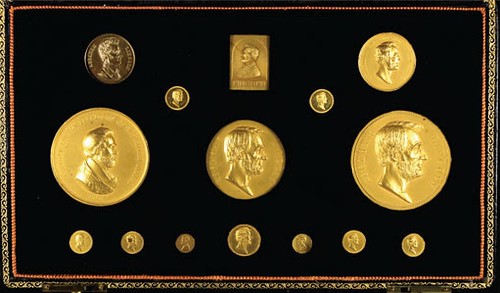 In our (Stack's) September 2010 Philadelphia Americana Sale we had the distinct pleasure of presenting for sale this unique collection of gold Abraham Lincoln medals, once a prized possession of Louis E. Eliasberg, Sr. At that time we elected to offer the set in 16 separate lots (15 individual gold medals plus the case and documents related to the set). One collector felt the set should remain together and succeeded in winning each lot in the set, keeping it intact. Five years later, when the owner decided to part with the medals, he contacted us, giving us a second opportunity to sell this historic property. Once again the medals were offered as 16 separate lots, and again, one collector sensed the importance of keeping these medals together as a set and aggressively bid for, and won, each of the individual lots. Now, for a third time, we are honored to present Mr. Eliasberg's gold Lincoln set at auction. This time, as the collecting public seems to prefer, it will remain as a set, including all 15 medals and the case, along with the supporting documents in a single lot. In the panorama of American medallic art, only George Washington has appeared on more medals than Abraham Lincoln. Beginning with the political medals and medalets of the 1860 presidential campaign, Lincoln appeared on an ever-increasing volume of medallic issues, including pieces mourning him upon his assassination by John Wilkes Booth and all the subsequent anniversaries of his birth and of major acts of his presidency, including the Emancipation Proclamation. Over the next 150 years, medals in every imaginable metal would be struck by the United States Mint and a wide variety of private manufacturers. 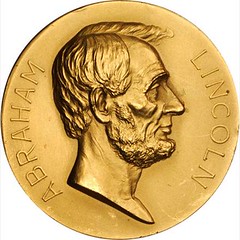 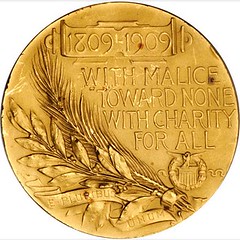 The extraordinary medals comprising this collection were first assembled by Judson Brenner, an early American Numismatic Association leader, whose collection was the basis of the Robert P. King catalog. The collection was handled after Brenner's death by Henry Chapman. It was purchased by T. James Clarke of Jamestown, N.Y. and was subsequently acquired by Stack's of New York City, who interested Eliasberg in the unique assemblage. Now Eliasberg's, the gold Lincoln grouping included the U.S. Mint's massive Lincoln Indian Peace medal, the impressive Presidential medal by George T. Morgan, the 1871 Emancipation medal and 1909 Birth Centennial issue and seven of the tiny Mint Medalets honoring Lincoln with other historic figures. Also included are those issued by the colorful New York professional numismatist Thomas L. Elder, a passionate Lincoln admirer until his death in 1948. Modern issues are highlighted by J. Henri Ripstra's rectangular Lincoln plaquette struck in the 1930s. Ripstra, a former president of the American Numismatic Association, was a skilled medalist in his own right. What an amazing collection. Kudos to Stack's Bowers for offering it intact this time, but also to the earlier bidders who
acquired and kept it intact along with the supporting documents. -Editor
To read the complete lot description, see: Lot 114: 1867 Cyrus Field Atlantic Cable Medal 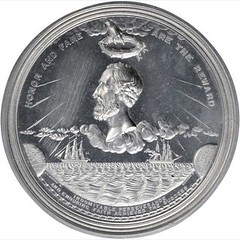 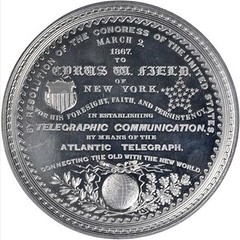 1867 Cyrus Field Atlantic Cable Medal. Aluminum. 102.4 mm. 137.5 grams. Julian PE-10c. Lustrous Mint State. According to Julian, six aluminum medals were special ordered - ostensibly by Field himself - in January 1868. The strike is definitive and the surfaces are as deeply reflective as they are untoned. Aside from a patch of hairlines in the left obverse field, and some very faint ones elsewhere, we see no problems of note. Of use in identifying this particular specimen, there is an intriguing planchet crack running entirely through part of the medal. It is visible, on close examination, starting at the second cloud on the left of the obverse, extending through the rim and edge, and visible on the left reverse from the rim at 8 o'clock and extending nearly 3/4 of an inch into the field below the E in TELEGRAPHIC. Although technically a flaw, the crack seems to add an additional level of interest to the piece. Struck when aluminum was essentially a precious metal, and in an early brittle, less malleable formulation, this large and dramatic medal represents one of America's great technological advances. The transatlantic cable was a monumental achievement of technology and business, the Internet of its day. This article likely
travelled a nearby route through fiber optic cables from the U.S to the U.K. and beyond. -Editor
To read the complete lot description, see: Lot 116: 1826 Erie Canal Completion Medal 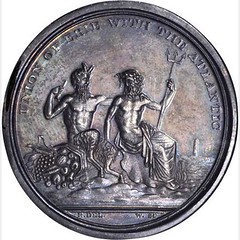 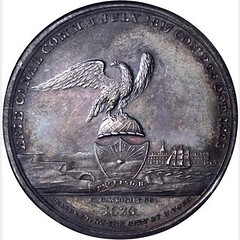 Famous 1826 Erie Canal Completion Dollar in Silver Designed by Charles Cushing Wright, the medal features Poseidon, Greek god of the ocean, and Pan, Greek god of nature, at the center of the obverse, both seated on a rock with a cornucopia, the ocean in the background with a lighthouse on shore. UNION OF ERIE WITH THE ATLANTIC curves above, R.DEL. and W. SC in the exergue. The reverse features an eagle at the center perched upon a demi-globe (much after the style of the pattern quarter dollar of 1792 by Joseph Wright), with an adorned shield bearing the Arms of New York below. A background scene of a sailing vessel and canal locks is present, ERIE CANAL COMM. 4 JULY 1817 COMP. 26 OCT. 1825 arcs above, C.C.WRIGHT SC / 1826 / PRESENTED BY THE CITY OF N. YORK on three lines in the exergue. No example of this medal has been graded equal to or higher than the present piece by NGC. The even more elusive round wooden presentation box is also included - not encapsulated, of course, and is complete and undamaged, still retaining both paper inserts. Numismatic Reflections by Q. David Bowers The Erie Canal was an earlier engineering marvel of huge importance to the economy of the U.S. -Editor
THE BOOK BAZARREWayne Homren, Editor The Numismatic Bibliomania Society is a non-profit organization promoting numismatic literature. See our web site at coinbooks.org. To submit items for publication in The E-Sylum, write to the Editor at this address: whomren@gmail.com To subscribe go to: https://my.binhost.com/lists/listinfo/esylum All Rights Reserved. NBS Home Page Contact the NBS webmaster 
|